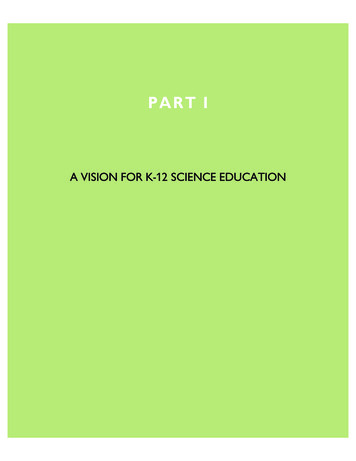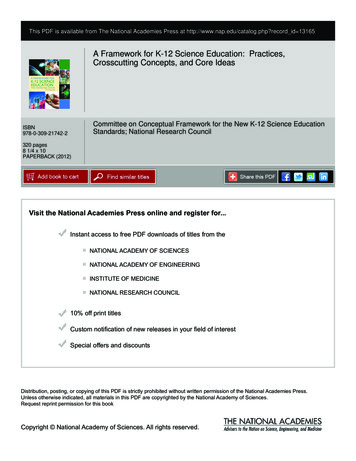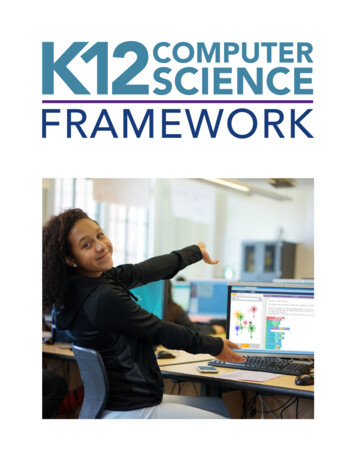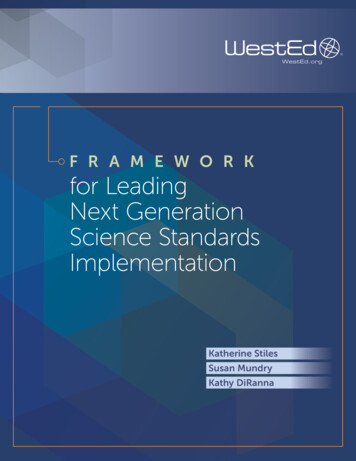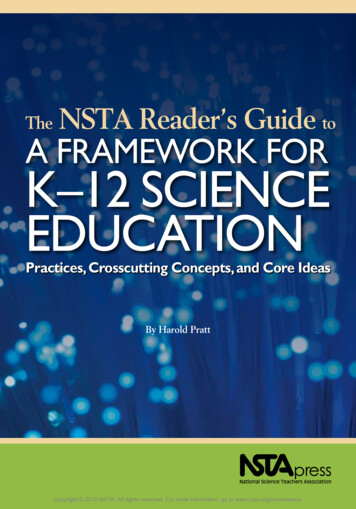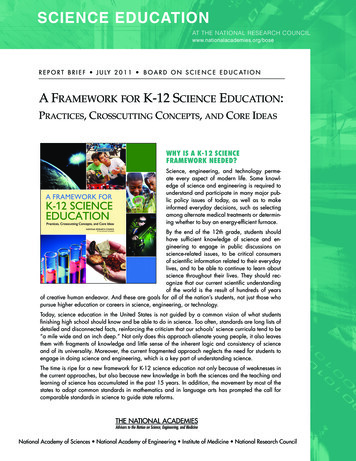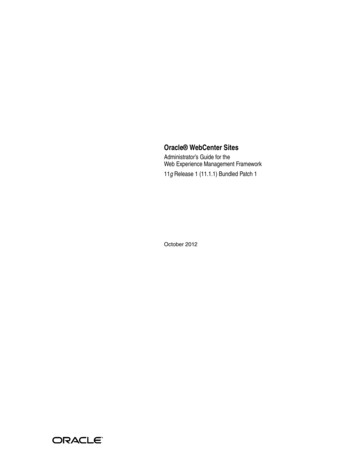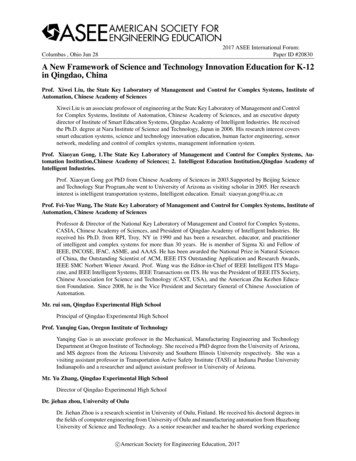
Transcription
2017 ASEE International Forum:Paper ID #20830Columbus , Ohio Jun 28A New Framework of Science and Technology Innovation Education for K-12in Qingdao, ChinaProf. Xiwei Liu, the State Key Laboratory of Management and Control for Complex Systems, Institute ofAutomation, Chinese Academy of SciencesXiwei Liu is an associate professor of engineering at the State Key Laboratory of Management and Controlfor Complex Systems, Institute of Automation, Chinese Academy of Sciences, and an executive deputydirector of Institute of Smart Education Systems, Qingdao Academy of Intelligent Industries. He receivedthe Ph.D. degree at Nara Institute of Science and Technology, Japan in 2006. His research interest coverssmart education systems, science and technology innovation education, human factor engineering, sensornetwork, modeling and control of complex systems, management information system.Prof. Xiaoyan Gong, 1.The State Key Laboratory of Management and Control for Complex Systems, Automation Institution,Chinese Academy of Sciences; 2. Intelligent Education Institution,Qingdao Academy ofIntelligent Industries.Prof. Xiaoyan Gong got PhD from Chinese Academy of Sciences in 2003.Supported by Beijing Scienceand Technology Star Program,she went to University of Arizona as visiting scholar in 2005. Her researchinterest is intelligent transportation systems, Intelligent education. Email: xiaoyan.gong@ia.ac.cnProf. Fei-Yue Wang, The State Key Laboratory of Management and Control for Complex Systems, Institute ofAutomation, Chinese Academy of SciencesProfessor & Director of the National Key Laboratory of Management and Control for Complex Systems,CASIA, Chinese Academy of Sciences, and President of Qingdao Academy of Intelligent Industries. Hereceived his Ph.D. from RPI, Troy, NY in 1990 and has been a researcher, educator, and practitionerof intelligent and complex systems for more than 30 years. He is member of Sigma Xi and Fellow ofIEEE, INCOSE, IFAC, ASME, and AAAS. He has been awarded the National Prize in Natural Sciencesof China, the Outstanding Scientist of ACM, IEEE ITS Outstanding Application and Research Awards,IEEE SMC Norbert Wiener Award. Prof. Wang was the Editor-in-Chief of IEEE Intelligent ITS Magazine, and IEEE Intelligent Systems, IEEE Transactions on ITS. He was the President of IEEE ITS Society,Chinese Association for Science and Technology (CAST, USA), and the American Zhu Kezhen Education Foundation. Since 2008, he is the Vice President and Secretary General of Chinese Association ofAutomation.Mr. rui sun, Qingdao Experimental High SchoolPrincipal of Qingdao Experimental High SchoolProf. Yanqing Gao, Oregon Institute of TechnologyYanqing Gao is an associate professor in the Mechanical, Manufacturing Engineering and TechnologyDepartment at Oregon Institute of Technology. She received a PhD degree from the University of Arizona,and MS degrees from the Arizona University and Southern Illinois University respectively. She was avisiting assistant professor in Transportation Active Safety Institute (TASI) at Indiana Purdue UniversityIndianapolis and a researcher and adjunct assistant professor in University of Arizona.Mr. Yu Zhang, Qingdao Experimental High SchoolDirector of Qingdao Experimental High SchoolDr. jiehan zhou, University of OuluDr. Jiehan Zhou is a research scientist in University of Oulu, Finland. He received his doctoral degrees inthe fields of computer engineering from University of Oulu and manufacturing automation from HuazhongUniversity of Science and Technology. As a senior researcher and teacher he shared working experiencec American Society for Engineering Education, 2017
2017 ASEE International Forum:Paper ID #20830Columbus , Ohio Jun 28in University of Toronto,Tsinghua University, Carleton University, INRIA/Sophia Antipolis, VTT/Oulu,Henri Tudor Research Centre in Luxembourg. He has published 100 plus peer-reviewed scientific articles.His research interests include education technologies, Internet of Things, pervasive service computing,cloud computing, virtual reality.Mr. Xiaofei Deng, Qingdao Experimental High Schoolc American Society for Engineering Education, 2017
A New Framework of Science and Technology Innovation Education forK-12 in Qingdao, ChinaRecently, the development of new technologies such as Internet of Things, Big Data, andCloud Computing have promoted the intelligentization of many industries and deeplychanged the way of human production and living styles. Last year, AlphaGo defeated the toplevel human experts of Go chess many times, marking the start of a new IT era, and here IT isnot Information Technology but Intelligence Technology. The new challenge of the K-12science and technology innovation education (STIE) is to cultivate young students withadvanced scientific literacy and help them to keep up the fast development in the IntelligentTechnology era.For the new IT era, we present a new STIE framework with iSTREAM multidisciplinaryintegration and CDIOS comprehensive processes ideas for K-12 students. iSTREAM andiCDIOS are natural extension of well-known STEM and CDIO (Conceive, Design,Implement, and Operate) programs, where i represents the new IT intelligent technologyelement for individual, inspiration, intelligence, invention, innovation, integration,interdisciplinary, international. Robotics, Research, Arts, Entrepreneurship, Management andService are added and emphasized to provide comprehensive and systematic learningstorylines from all dimensions.This work is supported by many selected elementary and middle schools in Qingdao, a largecoastal city with good educational background in China, and is also cooperated witheducational equipment companies, normal universities, academic institutes, and localgovernment. In this report, a brief review of our efforts on iSTREAM and iCDIOS will befirst presented, and then the corresponding STIE framework, including vision, dimensions,ways, etc. will be introduced.1. BackgroundWith rapid development of science and technology, we have entered a knowledge-,innovation- and talent-driven era, in which interdisciplinary and innovative high-tech talentsbecame the key winning resources. To keep up with the changing science and technology, itis very important to provide science education for schools from kindergarten to 12th gradeand even just pre-kindergarten. Especially STEM (Science, Technology, Engineering, andMathematics) or STEAM (add Arts into STEM) education originally from the US gives us avery valuable reference and inspiration. Over twenty years before, many countries such as theUS, the UK, Germany, France, Japan, etc, issued successively corresponding policies andstandards for STEM education, emphasizing the interdisciplinary nature of science educationand the combination of science, technology and engineering practice. Furthermore, SeymourPapert, the inventor of LOGO computer language, who is also thought as the father of themaker movement, has advocated a concept of “learning by doing” [1]. Till 2012, the concepts
of maker, maker space and maker education have gained more and more attention [2].STEAM and maker education have their own strengths and weaknesses and have a goodcomplementarity [3]. Therefore, Science and Technology Innovation Education (STIE) isproposed to combine the STEAM and maker education, and is accepted by more and moreK-12 schools in China.1.1 Global Science EducationIn 1996, American NRC(National Research Council) of NAS(National Academy of Science)issued the first national document “National Science Education Standard”[4] . In 2010, NAS,Achieve Inc., and AAAS (American Association for the Advancement of Science) started anew round of science education reform program, and issued “A Framework for K-12 ScienceEducation” in 2011[5] and NGSS (Next Generation Science Standard) in 2013[6]. In NGSS,for the first time, engineering and technology education was listed separately and added tothe standards of science education, and interdisciplinary learning and combination of scienceand engineering was emphasized. Knowledge from K-12 was reorganized into threedimensions: Science and engineering practice, crosscutting concepts and disciplinary coreideas. But how to implement this standard and balance interest among all stake holders suchas government, business, industries, finance, etc. needs to be further studied. In 2014,NASPublishing House published “STEM Integration in K-12 Education: Status, Prospects, and anAgenda for Research”[7], pointing out that there should be balance between integratedlearning and disciplines learning.In 2006, British Department of Education and Skill issued “The Science, Technology,Engineering and Mathematics Programme Report”[8], aiming at integrating the resources ofall stake holders to provide a coherent, diversified and lifelong education network for alllearners at a national level. At the same time, German Federal Education Department startedtwo-step reform process and issued “Development of national education standard”[9],redefining education objectives, competency models and evaluation systems based onthree-dimensional capacity model (capacity, subject knowledge content and ability level).In France, science education standards are developed for primary school, junior high schooland high school, respectively. In 2008, France implemented new science education standard“the new curriculum for primary school”[10], including discovery-oriented curriculum forprimary students, experiment-oriented for junior high students, and integration-orientedcurriculum for senior-high students. Japan's recent education reform was in 2008, with afocus on emphasizing scientific inquiry methods and life-related problem solving activities.At the 2013 Global STEMx Education Conference, Finland, Australia, New Zealand andother countries have participated to discuss science education for new era. Along with scienceeducation reform, original meaning of STEM (Science, Technology, Engineering, andMathematics) has been extended into many versions such as STEAM, STEMx, and etc. InSTEAM, A (art) was added to emphasized the cultivation of humanistic literacy, While inSTEMx, x means computer science, computation thinking, innovation and reform, global
communication and others, showing a great inclusiveness. And in this article, iSTREAM isalso proposed as a new extended version of STEM.1.2 Science Education in ChinaIn the mid-1990s, with rapid development of economy, Chinese universities beganlarge-scale enrollment, and then higher education transferred from elite education to masseducation, which also caused a relative decreasing in the quality of students with lowerlearning abilities. In 2010, China has become the second largest economy obtained by theexpense of resources and the environment. Therefore, there is an urgent need for innovativetalents to transform economy of China from resources-extensive to innovation-extensive.Upon the arrival of intelligent technology era, innovative talents with science and high-techliteracy are imperative needed more than ever. Since 2015, China has initiated “DoubleChuang” or “Tri-Chuang” national movement for Makers, Entrepreneurship and Innovators(MES) across all levels of government, researches, and education agencies. It is crucial toenhance and cultivate the science literacy of Chinese people K-12 and beyond by systematicscience education reform to keep up with international advanced education development.Along with global science education reform, China has been on the move and successivelyissued corresponding policies such as “National Science Literacy Action Plan” (also knownas 2049 plan), “Guideline for National Science Literacy Action Plan (2006-2010-2020)”,“Implementation of National Science Literacy Action Plan (2016-2020)”, etc., aiming atcultivating and enhancing Science literacy for all Chinese Citizens for the construction of aninnovative and comprehensive well-off society.However, challenges remain and problems need to be solved in China. First, “One mile widebut one inch deep” exists in China too [11]. All knowledge for K-12 needs to be reviewedfrom a systematic view, from a “theory with practice” view, from a “from life, by life, for life”view. That’s to reorganize knowledge based on big ideas in different subjects andcross-cutting ideas to guide students to know better and live together with this natural andsocial world in harmony. Then, teachers are the key, therefore, they need to more open andget trained on new educational ideas, new teaching skills, new teaching scenarios andadvanced educational technologies[12]; Third, evaluation system needs to be transferred fromtest-oriented system to multi-dimension-oriented systems step by step. Social educationresources such as museums and open scientific platforms need to be fully utilized for citizens[13]. Last, there are no integrated and unified standards from educational equipments, scienceinnovation curriculum, innovation labs, evaluation mechanism, etc. [14], so a top-downsystematic design of science innovation education system for K-12 and beyond needs to bedesigned to motivate all stake holdlers and optimize social education resources from alllevels.
1.3 STIE in QingdaoQiaodao, also known as "Eastern Switzerland", host city for International Congress on ICT(Information & Communication Technology) in Education twice, is a modern, advanced,international and coastal city. As one of the pilot cities of China’s Ministry of Education,Qingdao pulls full strength to STIE. Recently, the Qingdao government issued “Measures forPrimary and Secondary school management in Qingdao”[15], which is the first localgovernment regulation on school with a focus on building a new ecosystem amonggovernment, schools and society based on government management, school self-running,social participation and supervision .Qingdao Academy of Intelligent Industries (QAII) is an academy focusing on theindustrialization of intelligent technology based on the Institute of Automation, ChineseAcademy of Sciences (CASIA). QAII has utilized rich resources of frontier intelligentproducts and specialists to STIE, and is certified as a Qingdao Science popularizationeducation bases, an Innovation Education Base for Qingdao primary and middle schools anda science popularization education bases by Qingdao Association for Science andTechnology, Qingdao Education Bureau, and Chinese Association of Automation,respectively. QAII is committed to promote and implement k-12 STIE and build an effectivestandard system by Qingdao Education Bureau.2. Proposed STIE Framework2.1 Problems of STIE in ChinaSince 2014, STIE has been quickly spreading in China with more education funding fromChinese government, but problems come up successively. First, there is plenty of educationequipments with different quality levels from various supplier companies, which makes aheadache to pick the right product, so there may be a big waste on equipment with badselection. Second, support services on equipment are generally not enough, especially lack ofcurriculum development and teachers training, and it is a very hard work for school teachersto study these equipment and develop curriculums in their spare time; Third, most curriculummainly involves knowledge instillation with less engineering and technology practice, whichis not very helpful to promote students science literacy; Forth, tons of off-campus STIEtraining institutes with a variety of education ideas cannot give systematic top-downcurriculum design and related standards covering all grades, and teachers and students aretired to follow kinds of STIE services. Especially, it is very important to build acomprehensive evaluation index system to guide the selection or construction of equipment,curriculum, campus and off-campus STIE spaces, activities, etc. Finally, there is a highrequirement for STIE teachers with cross disciplinary background and rich engineeringexperience, so a well-designed STIE framework is necessary for these teachers to help themeffectively promote the students science literacy.
2.2 Demand Levels of K-12 Schools in ChinaAccording to our research, there are three demand levels for STIE in China’s K-12 schools.First, learning motivation for core subjects, such as mathematics, physics, geography,Chinese, etc. may be increased through STIE. It's true that some students show low interestson core subjects learning because of boring classes and heavy pressure. STIE classesgenerally involve many core subjects and demonstrate related knowledge in more interestingway. Second, STIE performance is considered in the evaluation system of school enrollmentpolicy. With the process of education reform, more and more universities, middle andelementary schools pay more attention to enroll students with excellent comprehensivecapacity and would like admit students with science and technology talent, so many studentsare intending to enhance their scientific innovation performance to enter into better schools.Last, also the most important demand is to cultivate students' scientific literacy, innovationspirit and practical abilities. In general, STIE gives more possibility to inspire the potentialand motivation of students with flexible teaching and learning model, and it is a good testarea to the new round of education reform in China.2.3 Design Philosophy of STIE Frameworkl nciaSo ipatioticparAll- roundDevelopedPersonsyalthHe vingliResponsibilityPracticalinnovationScticfou ientifnis onsand icimatioHu notatnCulturalconfoundationLearningto learnInddev ependenelopme tntInSeptemberof2016,“corecompetencies and values for Chinesestudents' development” (CCVCSD) wasreleased in Beijing Normal University[16]. As shown in Fig. 1, its key point isto cultivate "all-round developedpersons" from three aspects with sixliteracies: cultural foundation includinghumanistic connotations and scientificfoundation, independent developmentincluding learning to learn and healthyliving, and social participation includingresponsibility and practical innovation.Fig. 1 Core competencies and values for ChineseFromtheviewpointsofstudents’ developmentmulti-disciplinary and cross-disciplinaryintegration, the idea of iSTREAM is proposed as an extension of STEAM with consideringthe characteristics of Chinese K-12 students, such as the deficiency of training aboutleadership, critical thinking, project management, etc. In addition, Considering to strength theeducation of innovation, entrepreneurship, and especially problem solving capability for K-12students, iCDIOS is presented based on CDIO (Conceive, Design, Implement, and Operate)engineering education approach. The letter i in iSTREAM and iCDIOS means intelligentscience and technology, innovation spirit, inspiration, etc. In iSTREAM, Robotics, as anindependent element is added since we believe that Robotics will be an independent subject
with coming era of human-machine collaboration; Mathematics is changed into managementto cultivate Chinese students' abilities related to management; In iCDIOS, S as service isadded to complete the whole engineering process.2.4 STIE Frameworksystemindex systemEvaluation indexEvaluationSupport platformBased on the aforementioned problems,Student scienceSTIE activitysituation, and ideas, a comprehensiveliteracySTIE framework is proposed , asSTIE tutorOff-campus STIE basequalificationshown in Fig. 2 , including STIEequipment,STIEcurriculum,Education baseOn-campus STIE labon-campusSTIElaboratory,off-campus STIE education base,STIE labSTIE curriculumSTIE activity, information supportSTIESTIE equipmentplatform and evaluation index system.curriculumSTIE framework is designed from theFig. 2 Structure of STIE frameworksystem thinking viewpoint, involvingall factors of STIE. Obviously, the proposed framework is effective to help K-12 schools andgovernment to make plans for the STIE, and we believe the implement of the framework willpromote the core competencies of CCVCSD for all K-12 students and finally impel educationreform in China.There are couples of challenges for the implementation of the framework. First, educationalcontents are required to track the rapid development of intelligent technology and show thelatest cutting-edge technology development to K-12 students; The second challenge ismulti-disciplinary and cross-disciplinary integration based curriculum and learningenvironment design and professional lecturer team training; Last, the teaching and learningmode should be flexibly adjusted with the different educational requirements for knowledgepopularization and engineering practices for different ages.3. Description of All Components in the STIE FrameworkAll components in the STIE framework are described in detail in this section.3.1 STIE EquipmentSTIE equipment is the physical concept-carrier of iSTREAM and iCDIOS. Some populareducational equipment, such as drones series, 3D printing series, IoT (Internet of Things)system, robot series, VR series, etc., are utilized for STIE in QAII, and most of them areoriginally developed as industrial application. There are four rules to convert the industrialproducts to STIE application: 1. Encapsulation (similar to word): the STIE equipment shouldbe designed easily to be understood for objective K-12 students, and some technical detailsare concealed and transparent for the students; 2. Modularization (similar to grammar): To
employed the industrial products for STIE, it is very necessary to designed many modules,such as input from sensors, output to actuators, computing and processing, connectingpackage, etc. and objective students can analyze, organize, and utilize these module freely; 3.Systematization (similar to sentence): To design curriculum with the equipment, it isimportant to conceive the teaching and learning scenario when the industrial products aretransformed to STIE; 4. Standardization (similar to paragraph or article): the whole STIEframework should be inspected, some equipment may not be suitable to be used for STIE fora certain grade of K-12.3.2 STIE CurriculumSTIE curriculum is the soft carrier of iSTREAM and iCDIOS. Curriculum system for K-12should be designed from a systematic and integrative view to smoothly and seamlesslydeliver core ideas of each subject M(Management)and cross-cutting ideas behind them to learners,which is a balance between division and integration. Guiders or teachers are mainconcept-delivers and bridges between physical concept-carriers and learners. So throughteachers training services, teachers or guiders will learn how to realize and deliver core ideasby content organization, scenarios design, utilization of teaching skills, etc.3.3 On-Campus STIE LabOn-campus STIE lab is the off-line learning and communication platform for all learners andguilders. Working as an innovation unit or a maker space, the on-campus STIE lab containsSTIE equipment, STIE curriculum, teachers, learners, scenarios, etc. to create an inspiringatmosphere for innovation.3.4 Off-Campus STIE BaseOff-Campus STIE Base is the off-campus, off-line platform for learning and communication.Working as an experience center with cutting-edge science and technology exhibition,advanced intelligent equipment are assembled and deployed in the innovation education base.By demonstration, lecture, and on-site experience, students can know the state-of-artengineering practice and tendency of the intelligent technology development.3.5 STIE ActivitySTIE Activities including competitions, tours, expeditions, camps, etc. are supplement andextension of four components mentioned above, which make this framework an open system.First, learners and guiders could get out of schools, experience fresh and up-to-date scienceand technology, brainstorm with new minds, get more chances to find, ask and solvelife-related questions and generate new inspirations. Second, through all kinds of activities,
this framework can make full use of community education resources, and generate morecertain economic and social benefits.3.6 Support Platform based on Parallel Teaching and Learning SystemSupport Platform based on a Parallel Teaching and Learning System(PTLS) is an onlinelearning and communication platform based on ACP (A: Artificial Societies, C:Computational Experiments, P: Parallel Execution) approach. By building one or moreartificial societies including learner models, guider models, environment model, etc., eachreal entity has one or more corresponding virtual entities. That is to say, we are not alone, andthere are one or more “copies” of us in artificial societies; By carrying out different kinds ofcomputational experiments in artificial systems to find the most suitable strategies such asteaching methods, learning scenarios, etc. Then, these strategies will be applied in realeducation process to test their efficiency. After that, real education process will generatefeedback into virtual system to do more strategies optimization. Then such interactions willkeep back and forth until balance between real education process and virtual system isobtained. That is parallel execution [17-19] as shown in Fig. 3, in which real learners andvirtual learners, real guiders and virtual guiders are evolved together by learning from eachother through computational experiments to find the most suitable teaching strategies.Fig. 3 Supportive Parallel Teaching and Learning System3.7 Evaluation Index SystemBased on iSTREAM and CDIOS, an Evaluation Index System(EIS) was dedicatedlydesigned to ensure that equipment, curriculums, labs, tutors and students science literacy areSTIE-qualified. That is to say, with right input (equipment, curriculum, lab, tutor), we couldensure the right output (students science literacy). By doing so, we believe we can achieve amuch better result in a more efficient way.4. Implementation model of STIEIn order to provide an effective, sustainable, all-win STIE ecosystem, we origianlly presentimplementation model of STIE by balacing and motivating interests of all stake holdersincluding government, commerce, industry, university, research institute and finance entities.
Under guidance and support from local government (generally education bureau), iSTREAMresearch institute design the STIE framework and standards in a top-down way, and lead theSTIE equipment suppliers, training institutions to develop curriculum with the support ofnormal universities and finance companies. This implementation mode features top-downsystem design, balance of benefits, and concentration by professional participator.Financing mode: PPP, BT, BOT, etc.FinancingcompaniesGovernment(Education burea)Budget & guidanceFinancial cooperationK-12 SchoolMaintenance and trainingTeaching &trainingSTIE framework basedtotal solutionFinancial cooperationSTIE frameworkScientific research andindustrializationEPC orotheriSTREAM cation equipmentScientific entSTIE projectFig. 4 Multiple cooperation of inance5. Application CaseSo we take Qingdao as an example to show how this framework works and challenges wehave met.5.1 STIE EquipmentSome equipment we are utilizing in Qindao is briefly introduced here.3D Printer SeriesWe consider 3D printing as a powerful and magictechnology, which could turn learners' innovativeideas into reality. That is to say, whenever learnersneed any kind of parts not available at market, theycould easily print them out with 3D printers afterconceiving and designing on our 3D designFig. 5 Industry-level 3D printeroutsourcing platform. That is to say, based on3D-printing manufacturing platform, learners can extend and expand our educationequipment based on their innovation, thus creating personalized equipment for all based onone basic series product.As shown in Fig. 5, we developed industry-level 3D printers to make sure all printed parts aretotally reliable with high precision. 3D printer series is one of our basic and powerful scalable
educational products for all grades. For lower grades learners from K-4, we provideeasy-touch platform to motivate learner's interest; for middle grades learners from 5-8, weprovide easy-design platform to simplify designing process based on tons and tons of models;for higher grade learners from 9-12, we provide an open-platform which could inspirelearners' sparkles and empower them with outsourcing ecosystems.Robotic Fish SeriesBionic robots are popular and playful becausethey combine everything together smoothly andnaturally. As shown in Fig. 6, we developedrobotic fish series equipment to meet kids'interest by driving their life experiences. WeFig. 6 Robot fishprovide scalable series from easy to complicatefrom K-12. For K-4, we provide basic swimmer robotic fish which could be assembled underguidance. For 5-8, we provide intermediate-swimmer robotic fish which let learners' exploremore robotic fish science, engineering and others. With help of 3D printing, learners couldchange outer skin or skeletons inside For 9-12, based on more comprehension of robotscience, engineering and others, learners could conceive, design, implement and operate theirown robotic fish or cool stuff swimming freely on the surface or under the water to undertakecool tasks such as detecting pollution, exploring undersea and etc.Virtual Reality SeriesVirtual Reality Series are a fantastic portal to wonderful and magic land for everyone andalso bridges to connect real world and parallel virtual worlds where learners could explore allcorners of our universe, create their own imaginary worlds, and finish mission impossible inreal world. So for K-4, we provide sea-world equipment to let kids explore world under thesea with 3D glasses they made by themselves; for 5-8, we provide parallel-world
new round of science education reform program, and issued “A Framework for K-12 Science Education” in 2011[5] and NGSS (Next Generation Science Standard) in 2013[6]. In NGSS, for the first time, engineering and technology
